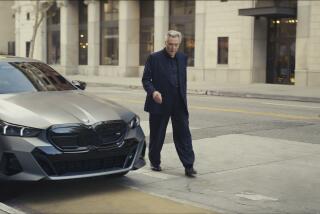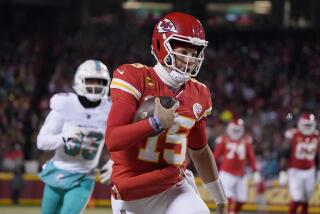In Super Bowl of Commercialism, Pepsi Ads Score Best With Viewers
In this year’s Super Bowl of advertising, nothing else was a Pepsi.
The soft drink company produced what was probably the game’s most memorable advertising, marketing executives said Monday. And viewers remembered the Pepsi commercials best, followed by ads for Budweiser and Doritos, according to a survey conducted right after the game.
But opinion was mixed on whether Pepsi’s humor-laced spots--linked with the slogan “Nothing Else Is a Pepsi”--would motivate consumers to buy some.
The Super Bowl has evolved over the last decade into as much of a showcase for advertising as football prowess. This year, advertisers paid a record average of $1 million for a 30-second spot in the big game. Pre- and post-game slots went for up to $500,000.
Advertisers spending that kind of money, compared to about $170,000 for a typical prime-time TV spot, are looking to make a big impression on consumers.
According to Jo Muse, chairman of Muse Cordero Chen, a multiethnic Los Angeles agency, Pepsi probably succeeded. The commercial showing a little boy sucking himself into a Pepsi bottle on a beach, while his sister watches, was “a fresh approach, with a taste message, an outstanding piece of work,” Muse said.
*
Muse gave high marks to an amusing Budweiser spot in which frogs croaked the beer’s brand name. “A classic case of building brand image,” he said.
According to a post-game survey by Creative Marketing Consultants, a Southfield, Mich.-based research firm, viewers remembered the Pepsi commercials best; those for HBO, Primestar satellite TV and Soloflex exercise equipment were remembered least.
The survey didn’t ask the 350 people polled nationwide whether they actually liked the ads.
In interviews, advertising executives said some advertisers may have been trying so hard to create a memorable ad that they obscured the message.
Jack Roth, president and chief executive of the Los Angeles-based agency Admarketing, said former Govs. Mario Cuomo of New York and Ann Richards of Texas, appearing in a Doritos ad, outshone the product.
“I had a little trouble understanding what the message was. There was this talk about change and then you find out they changed the package,” Roth said. “I’m not sure it would make me buy Doritos.”
Marketing executives were puzzled by Taco Bell’s series of “Border Lights” teaser ads. The commercials never said what menu changes the company plans as part of the “lights from the border” theme.
“There’s this big buildup, for what?” asked Jack Trout, a Greenwich marketing consultant.
Taco Bell plans to introduce the changes soon.
Trout said the message also got lost in a Pepsi commercial in which a man desperately tried to force a machine to take his rumpled dollar bill.
“It’s a nice piece of TV, but it is not a great selling message,” he said, pointing out that the ad said nothing about the product itself.
Timing was also important. The lopsided victory by the San Francisco 49ers meant viewers started bailing out in the third quarter, and when the game ended, they tuned out in droves.
Honda, whose commercials aired in the last quarter, said it was satisfied with how the game went. According to a sampling by A.C. Nielsen of the nation’s 32 biggest markets, 41% of households were tuned in at the start of the game, 40% with half an hour left, and only 24% at the end. “It is a gamble, but we’d do it again if we had a new product to introduce,” said a Honda spokesman.
More to Read
Inside the business of entertainment
The Wide Shot brings you news, analysis and insights on everything from streaming wars to production — and what it all means for the future.
You may occasionally receive promotional content from the Los Angeles Times.










